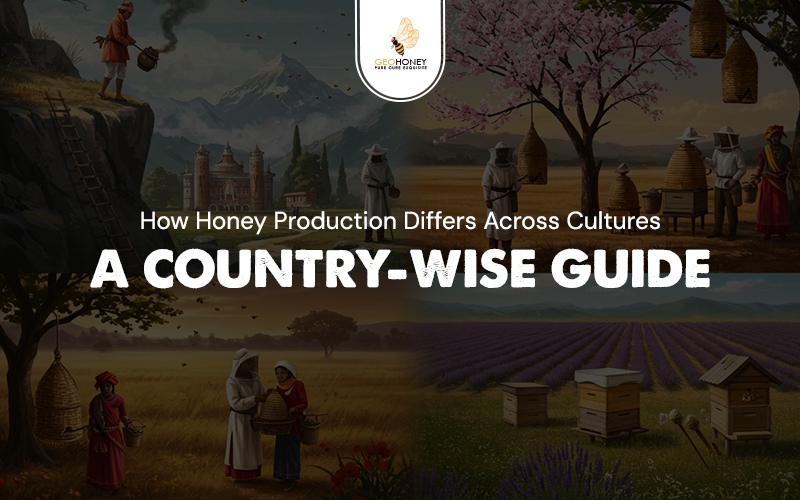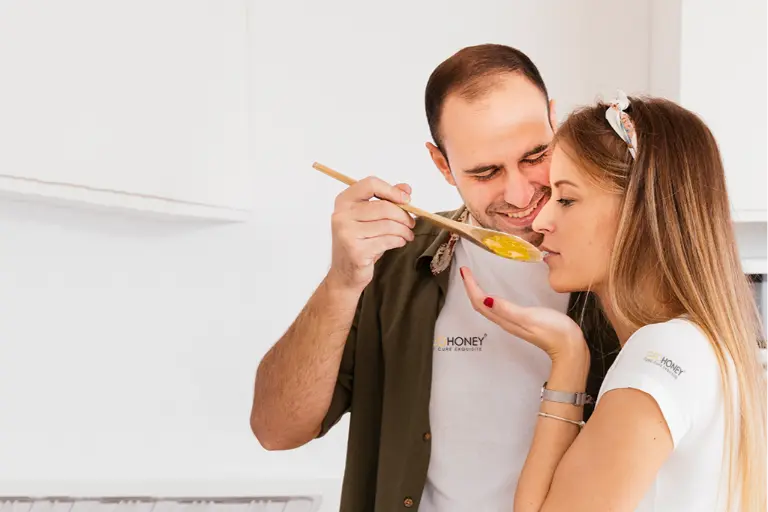- Tokyo: 19:16
- Singapore: 18:16
- Dubai: 14:16
- London: 10:16
- New York: 05:16
How Honey Production Differs Across Cultures: A Country-Wise Guide

Do you know that honey has been used for over 8,000 years? It never spoils, and bees must visit around 2 million flowers to make one pound of honey. We can go on and on.
What’s even more interesting is how honey production varies across cultures. It is then that honey stops being a food and becomes a window into tradition, environment, and innovation.
This blog explores country-wise honey production. It also takes a look at how it is consumed and celebrated around the world.
Why Does Geography Matter?
Geography affects honey production through a combination of climate and floral diversity. They interact to create a unique characteristic that is imbued in the honey due to its environment.
The diversity of floral plants available for the bees to collect nectars from affects the flavor and aroma of the honey. Moreover, geography affects how beekeepers manage the bees and their foraging patterns.
The foraging patterns of bees and their behavior are also significantly affected by the climate of the geography. For instance, rainfall and humidity affect the availability of nectar and pollen. Warmer temperatures encourage more foraging while ambient temperature affects an enzymatic activity within the hive.
All of these factors together affect the taste, texture, and aroma of honey.
Honey Production in Europe
Germany
Beekeepers in Germany made use of traditional beekeeping methods. It featured the use of skeps, baskets woven from straw, and hazel twigs. One of the reasons why skeps were popular in Europe, especially Germany, is because of their ability to keep bees warm during winter. The thick straws provide excellent insulation.
However, there are certain problems with using skeps. This is why beekeepers have moved towards modern practices. Unlike modern hives, skeps cannot be opened for inspection, making it difficult to inspect for diseases or pests. Additionally, harvesting honey often means destroying hives, which is not sustainable in today’s time.
Romania
Beekeeping in Romania is both a centuries-old industry and a growing modern industry. Research on Organic Beekeeping Practices in Romania reveals a mix of stationary, migratory, and mixed types of beekeeping practice. This means that honey is produced using handcrafted hives as well as transhumance. Transhumance is the seasonal movement of bee colonies to follow blooms across the regions.
Slovenia
Slovenia is popular for its Carniolan bee, which is native to the region. The country’s beekeepers are a powerful force. They see beekeeping as a way of life rather than for the sake of producing honey. Slovenia is one of the first EU countries to ban the use of neonicotinoid pesticides to preserve their bees.
They use unique ‘AZ Hives,’ named after Anton Žnideršic. These small-scale, painted hives allow better monitoring of bee colonies. It also protects bees from harsh winter conditions. Their honey production practices are highly localized, with the country banning the import of other bee species to avoid new diseases.
Honey Production in Asia
China
Traditional beekeeping in China makes use of bamboo hives. They are lightweight and durable, allowing for easy transportation and manipulation of the bees. Additionally, they use a tool called “honeycomb scraper” to harvest honey. The tool scrapes off the honey without damaging the wax, making it a labor-intensive process. Furthermore, they use smoke before inspection or harvesting to calm the bees.
When it comes to honey harvesting, they use a variety of techniques. One of the oldest ones is hand-skimming. Here, the beekeeper pours the comb into a container by breaking apart the comb without damaging the wax cells.
Another technique, centrifugal extraction, involves using a spinning drum to separate honey from wax and debris. Here, they remove the comb and place it in a centrifuge, a special piece of equipment.
Japan
Japan is home to many migratory beekeeping operations. Here, beekeepers make use of hchido, a traditional practice where bees are confined to a small area and fed on nectar from wildflowers exclusively for honey.
Honey Production in Africa
Across Africa, beekeepers use bamboo, raffia palm, or hollowed-out logs to create handcrafted hives. These are sustainable, locally sourced, and closely resemble the bee’s natural habitat.
In Kenya, top-bar hives are very common. They are easy to construct, inspect, and control for pests. Furthermore, these hives are placed in areas that require reforestation. As a result, bees help pollinate new plants and speed up forest recovery. They use a variety of techniques, like smoking the bees to a temporary stupor and specialized tools to avoid damage to the bees and the hives.
Conclusion
Honey production and beekeeping highlight a mix of traditional practices strengthened by new-age techniques and technologies. It is important to remember that while bees follow the same instinct everywhere, how we harvest and use honey reflects who we are.
Each culture and practice adds its own story to this golden liquid. Of course, as sustainability becomes a driving factor, honey production may evolve, but its roots in culture and community will likely stay just as strong.
GeoHoney focuses on delivering 100% raw, natural, and organic honey. Check out our entire collection of over 200 types of monofloral honey, freshly harvested from our farms located in over 500 locations across the globe!




A country-wise guide for honey helps you understand how different countries produce, consume, and specialize in various types of honey. It also covers unique honey varieties, regulations, and traditions.